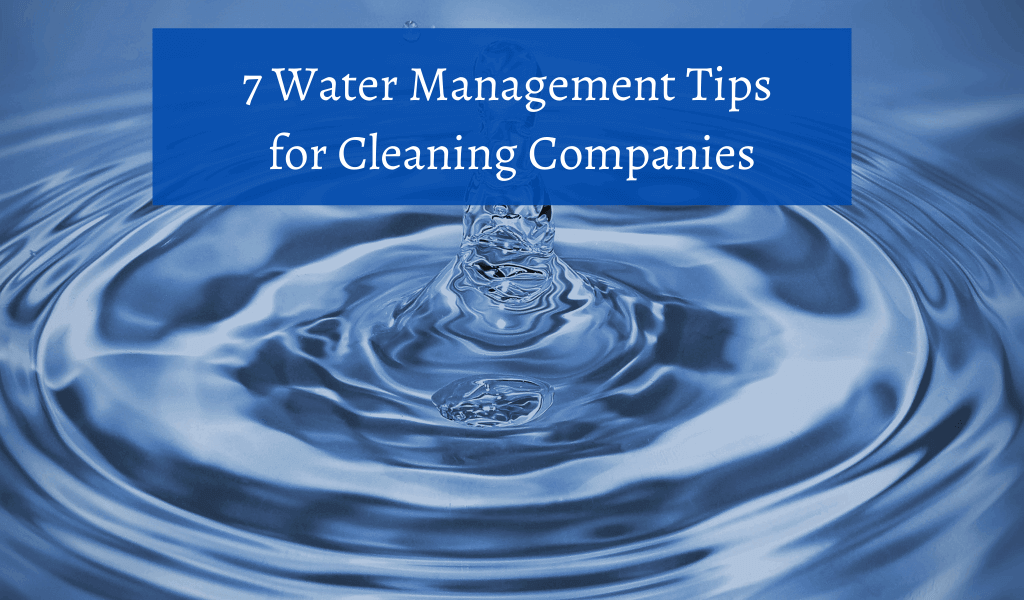Cut down on waste in your commercial cleaning business with these water management tips based on verified conservation practices.
There’s no way around the fact that the commercial cleaning industry uses a substantial amount of water. Some of it is unavoidable, as we dilute cleaning concentrates or steam clean carpets. However, there’s also a lot of room for improvement and cutting down on waste. These water management tips can help.
First, let’s look at some of the reasons water management is so important. Conservation is certainly a valid and admirable goal on its own, but using excess water is also expensive.
The engineering department at the University of Nebraska conducted several studies on water usage in different cleaning situations. In one, they found that switching from standard cotton mops to microfiber cloth mops for one year could save over 23,000 gallons of water and $4,870 in supplies and utility costs. They also found that a microfiber mop saved an “average of six minutes of labor per room,” while potentially reducing worker injuries due to its lighter weight.
Paying attention to conservation-informed water management tips also makes your commercial cleaning business more attractive to many people who will hire you. Facility managers and business owners are looking for easy ways to improve their environmental friendliness. Whether it’s for marketing purposes or based on personal beliefs, a water-conscious cleaning company is something they can boast about on their website and social media channels.
Still, you do need to use water in your commercial cleaning operations. So how can you optimize your management of that resource?
Increase efficiency, reduce costs, and improve results. With Janitorial Manager, all this and more isn’t just a dream, it’s your new reality. Contact us for a free demo right now and see how it works!

7 Water management tips that will help you save money, save water, and win over clients
Some of these water management tips are easy to implement. Others may take some time and even a financial investment to put into place. Just remember that any steps you can take in the right direction will eventually pay off.
1. Switch to microfiber mops. Just in case you skipped the intro, microfiber cloths can save somewhere in the range of 85 to 90 tons of water each year and thousands of dollars in supply costs. That alone seems like a good reason to go water conscious!
2. Turn the water off when you aren’t using it. This is one of the most straightforward water management tips, and yes, so many of us leave the water running much longer than we should.
3. Use automatic dilution systems. These systems take the guesswork out of the cleaner and water ratio. They’re set up to dispense the correct amount of cleaning solution, so you don’t waste either water or product, and you can rest assured that facilities are getting the needed amount for proper cleaning and disinfecting.
4. Set up a reporting system. Especially if repairs and maintenance are outside the scope of your contract, be sure you have a reporting system in place so employees can notify managers or building personnel if they notice any water leaks in the building.
5. Hire robots. No, robots will not replace your workforce. They will, however, conserve water since they do the same job every single time.
6. Train, train, train. One of the water management tips guaranteed to get results is to train your team. It doesn’t cost you anything; it makes your company better overall and ensures they will operate efficiently when it comes to water and product conservation.
7. Invest in energy-efficient, water-efficient machines. Similar to robots, new commercial cleaning machinery can do a lot to save water and also boost your team’s efficiency. New technology offers more scrubbing power, programmed solution and water doses, fewer leaks and spills, onboard water recycling, and may require less maintenance.
If you have the ability, there are still more water management tips you can take advantage of. Most, however, require changes to the facility structure, such as low-flow toilets, automatic-shut off faucets, more water-conscious landscaping or landscape watering practices, and similar projects.
As a commercial cleaning business, you may not be able to do very much about these larger issues. And it may take time before you can invest in newer, more technologically advanced machinery.
However, there are still steps you can take to manage your water usage more effectively. That will save money for you, for your client, and it’s good for the environment. That’s what they call a win-win-win situation.
If you are ready to bring your cleaning organization to the next level, take advantage of a free call with Janitorial Manager to see how our software can make you a more successful janitorial operation.

